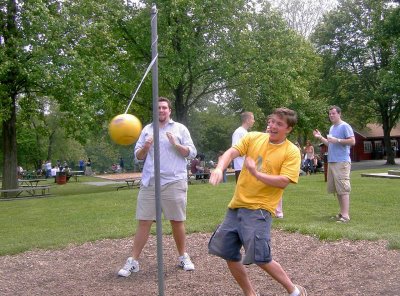Tetherball

The Rules of Tetherball:
For any game to work well, it needs rules that make play as lively and as fair as possible. The rules by which many people play tetherball fall far short of making the most of the game. The tetherball rules described below are the best I have used.
Games and Matches:
A game is won when one player has wrapped the rope as far as it can go in her own direction.
The outcome of each game is powerfully influenced by which player serves, as explained below. For this reason, a match must consist of several games, with the players taking turns at serving. The players can choose how many games must be won to win the match, but the margin of victory must be at least two games, otherwise the player who serves the first game will be at a disadvantage.
Serve:
In tetherball, possession is everything. Once a good player gets control of the ball, her opponent is in trouble.
In the most common rules of tetherball, one player serves, then either player can hit the ball from that point on. Under these rules, the server has an immense advantage. She has complete control of the ball from the start of the game, and if she's an advanced player facing an opponent of equal skill, she should be able to hit the ball over her opponent each time it comes around, wrapping it to win the game without her opponent even touching the ball.
The better rule requires the server to wait until either the opponent strikes the ball or the ball has wrapped four times before she can strike the ball again. This actually gives the receiver the advantage, because he gets the first chance at unrestricted control of the ball. His advantage, though, is tempered by the fact that the server can wind the ball at least one wrap in her own direction and use an angled serve to prevent him from getting a clean first hit on the ball. This makes the contest as fair as it can be, although winning one's serving games is still about as rare in advanced tetherball as breaking serve is in advanced tennis.
Direction:
Given the disadvantage of serving, the server may choose in which direction to hit for each game in which she serves. For each new game that she begins, she may choose either direction.
Penalties:
In many versions of tetherball rules, all violations result in loss of game. A fairer system distinguishes between intentional and unintentional violations.
Unintentional violations include the following:
* Stepping off sides.
* Touching the rope.
* Carrying or throwing. When hitting a ball back against the direction from which it comes, the ball should bounce off the hands immediately, with no lingering contact. When hitting a ball that has passed the opponent and continuing it on its way, the ball still cannot be carried or thrown, but a less distinctive impact is to be expected. Serves must be hit, not thrown.
* Double hitting may or may not be intentional, but we give the benefit of the doubt. A player can hit the ball only once per wrap around the pole, except if the ball hits the pole between hits. He could conceivably "dribble" the ball against the pole, but this would be of little advantage, because he would not gain any wraps, and his opponent would likely get an opportunity to steal the ball.
When one player commits any one of these violations, the ball is stopped and returned to the place it was wrapped when the violation occurred. Both the number of wraps and their height should be re-created. The other player gets to serve, then either player can hit the ball from that point on. If a player commits three unintentional violations, in any combination, the opponent wins the game.
The only intentional violation is grabbing the pole. The penalty is immediate loss of game.
If both players commit a violation at the same time, then a "pole drop" is performed. Both players place one hand on the ball, holding it three feet out from the pole, directly above the line dividing the forward ends of their two sides. They release the ball simultaneously. Once the ball hits the pole, either player can hit it, and play continues normally.
Other rules:
All specific violations are listed above. Other violations would fall under the category of "unsportsmanlike conduct," which we needn't explain here.
Tactics such as hitting the ball in the opponent's direction to gain control are essential to the game, and rules outlawing them only limit the fun and sophistication of the game. Also legal are punching the ball, jumping directly in front of the opponent, and any other tactics that are consistent with good sportsmanship and not specifically prohibited above.

0 Comments:
Post a Comment
<< Home